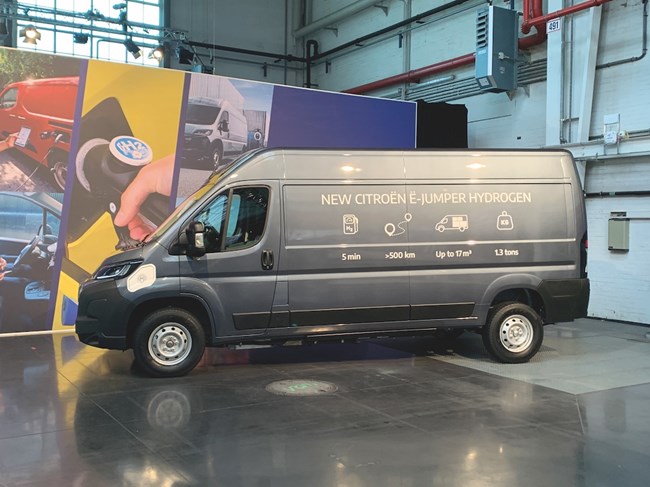- Orders open for Ineos Grenadier Commercial
- Toyota Hilux range gains new rally-inspired GR Sport II variant
- Remarketing: Pick of the bunch
- GA Commercial acquires first vans through Vanaways
- 'Luxury' tax on expensive pick-up trucks suggested
- ADVERTISEMENT FEATURE: Essential advice to avoid the van fleet ICE-berg
- ETRUX launches new Ford E-Transit Trizone
- Renault gives UK debut to Master E-Tech at CV Show
- Isuzu D-Max long-term test – Latest Report
- Isuzu D-Max V-Cross Steel Edition revealed
IVOTY Report: Stellantis explores the hydrogen proposition
Date: Wednesday, April 24, 2024 | Author: George Barrow
With comprehensive ranges of ICE and BEV models already available, the automotive giant is now launching a large hydrogen fuel cell van.

Stellantis Pro One was created towards the end of last year to symbolise the unification of the many Stellantis brands that now exist under its commercial vehicle umbrella. Citroen, Fiat Professional, Peugeot and Vauxhall brands are now all built off shared platforms producing an unparalleled number of vehicles.
With small, medium, and large models from four brands as well as internal combustion engine (ICE) and electric powertrains, there’s 24 individual models. Now all of them have been refreshed in some way, simultaneously, in an unprecedented renewal of the group’s light commercial vehicle line-up.
But the models aren’t just limited to battery electric vehicles (BEV) and diesel (and some petrol) engine models. Stellantis has also been working on incorporating hydrogen fuel cells into its van range with a mid-sized van available in France and Germany since 2022. Built as a manual conversion, off the production line, the medium-size hydrogen has enjoyed a degree of commercial success and has helped inform the production of an additional model on the large van platform chassis.
Due to payload and range compromises for large BEV vans, hydrogen makes more sense, increasing range, reducing “refilling” time compared to EVs and maintaining payload – all while being zero emission. Despite a slow roll out of hydrogen filling stations across Europe, a European Commission roadmap to create refuelling points within 200km of each other across the entire network of major EU roads will enable hydrogen vans to become viable for many more customers.
However, creating a hydrogen vehicle using an existing platform is not a straightforward process. Renault-owned Hyvia has opted to install its hydrogen tanks on the roof for its first-generation van in an effort to become first to market with a large fuel cell LCV. While the next generation Master (deliveries for which will begin later this year) will enable hydrogen fuel tanks to be incorporated into the chassis, Stellantis has managed to modify the configuration of their mid-sized van’s fuel cell system into the larger model thanks to its renowned ability to work for conversions – largely in the campervan segment.
“The installation of the fuel cell system was more challenging than in the mid-sized van,” explains Stellantis hydrogen programme chief engineer, Peter Gross.
“The large van in terms of interior to exterior dimension is best in class, there’s nearly no empty packaging space left, so that is why the package looks quite different to the medium-sized van,” he explains.
While both medium and large vans are based on their BEV siblings, the medium van used the space under the bonnet to stack the fuel cell on top of the electric motor used to drive the front wheels. Gross explains that in the larger version this didn’t work, prompting his team to look elsewhere. They opted to use the location previously utilised by the large van’s diesel tank, located under the front seat.
“Package space was found under the front seat, there is a large diesel tank that has been removed and with some modification of the sheet metal there was a chance to put the high voltage battery and the fuel cell stack into this space.”

The new location means the air filter now sits in the front of the van, feeding air to a cathode just behind it that is linked by pipework to the fuel cell under the seats. Hydrogen is then fed into the fuel cell from the tanks located in the rear of the van between the chassis rails. Power is then either used for propulsion or stored in the battery underneath the fuel cell. Apart from the layout, there’s also one other significant difference between the medium and large vans.
“In the mid-sized van the battery was actually in the interior of the vehicle, but in the large van it’s in the floor with the other [components],” Gross explains. The result is an easier and more logical installation that will enable the large hydrogen van to come as a right-hand-drive van as early as next year. Unfortunately, the same isn’t true of the mid-sized van. Despite Stellantis launching the van more than a year ago and having moderate success in France and Germany – two countries with a relatively established network for hydrogen refuelling – it is only now being rolled out to additional markets. The Netherlands, Belgium and other countries in western Europe all feature on the product plan. However, the UK will not for this generation of vehicle. Gross says that it will take a few years for the medium van to be available in right hand drive with a fuel cell, meaning not before the next generation van.
On the other hand, the large van was “considered from the very beginning” according to Gross due to Stellantis’ well-developed home delivery and courier services. While the UK doesn’t have a public infrastructure capable of supporting private use of hydrogen fuel cell vehicles, Stellantis is clearly expecting some private businesses to invest.
“It’s well known that the UK is very open to alternative fuels and the fuel cell proposition,” Gross claims.
“The medium van, will not come as right-hand drive in the next few years. It will come with the next generation. Physical constraints are always an issue if you take an existing vehicle and want to install fuel cell components, you have to live with certain restrictions,” he adds.
Despite no right-hand-drive hydrogen medium vans, Gross says hydrogen is growing in popularity. They’ll also be greater visibility later this year when the fuel is used for passenger vehicles around Paris during the Olympics.
“The market demand is growing, and it’s important to have these products available to give customers options. There is no other OEM offering mid-size and large hydrogen vans. With the European Highway [charging infrastructure], the door will be open to use these vehicles all over Europe,” Gross says.
With hydrogen uptake and infrastructure being such a chicken and egg scenario, building a viable product is the best solution manufacturers have. That’s why Gross says considerable effort was made to ensure that as much hydrogen was able to be carried as possible. The addition of a fourth tank, compared to the medium van’s three, makes the large van a much more usable prospect for the fleets that are likely to be the primary buyers. That capacity, however, was only possible due to the large van’s innate ability to carry payload. Luca Marengo, Stellantis commercial vehicles’ head of global product, attributes that to the van’s design and long standing success as a converted vehicle.
“The Ducato and these [large Stellantis] vans have always been popular with conversions, particularly motorhomes. Storing clean and waste water is something they have always done. That has helped with the space in the chassis for the hydrogen,” Marengo explains.
Ultimately the market will decide how much of a success hydrogen vans will become, but with large vans and fleet customers, they stand a fighting chance. The scalability of the design will also help with a powertrain used across medium and large vans, there’s hope that like electric motors and modular battery packs, sales volume will reduce the price and bring hydrogen to the mass market.
Is hydrogen feasible?
It’s been at least three years since my first serious discussion with an engineer about hydrogen and during that time it feels like the industry hasn’t really moved on. There’s been a huge amount of energy and noise created around electric vehicles, but the hydrogen movement appears to have stagnated. Mercedes has lost confidence in it, to an extent, Toyota has too. Even the heavy truck manufacturers have dialled down their enthusiasm, choosing instead to talk about the here and now – electric vehicles.
I’m hopeful that a credible product from Europe’s largest commercial vehicle maker will finally kick start not only a serious conversation about hydrogen but some serious commitments too. The payload is similar to a BEV and there’s just a 250kg differential between it and a diesel. Furthermore, fuelling can be done in the time it takes to fill a diesel tank rather than the 30 or 40 minutes needed to charge electric vans.
If hydrogen is to be the replacement for diesel – and I truly think in time it will be for commercial vehicles – there needs to be credible solutions from bona fide manufacturers from the off. Europe might have to think creatively to create the hydrogen needed, but the energy storage potential (particularly overnight) and ability to efficiently fuel and utilise the vehicle parc of a fleet is the main reason why we should all think more highly of hydrogen.
George Barrow is the UK jury member for the International Van of the Year Award
View The WhatVan Digital Edition


